Page 211 of 1690
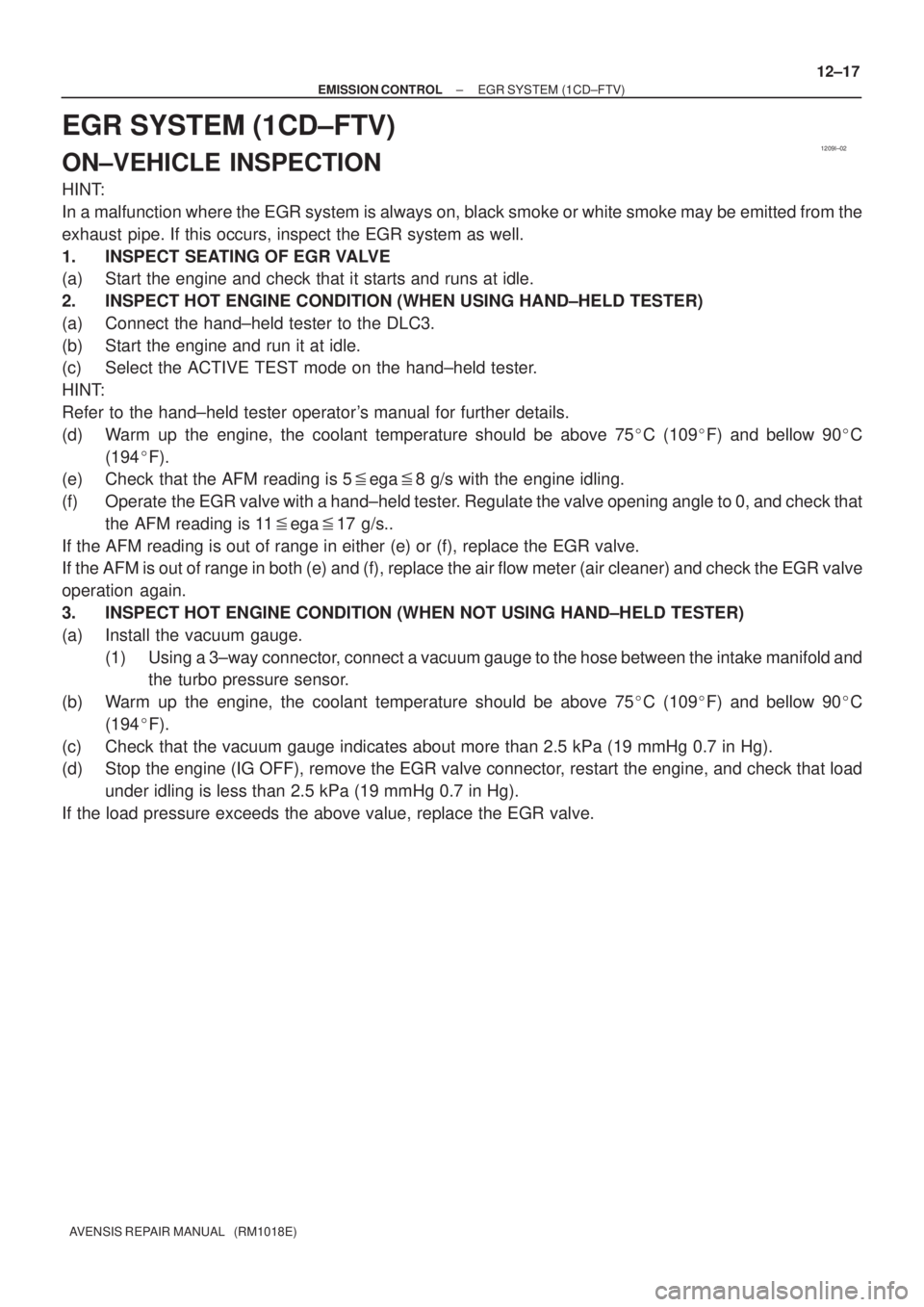
1209I±02
± EMISSION CONTROLEGR SYSTEM (1CD±FTV)
12±17
AVENSIS REPAIR MANUAL (RM1018E)
EGR SYSTEM (1CD±FTV)
ON±VEHICLE INSPECTION
HINT:
In a malfunction where the EGR system is always on, black smoke or white smoke may be emitted from the
exhaust pipe. If this occurs, inspect the EGR system as well.
1. INSPECT SEATING OF EGR VALVE
(a) Start the engine and check that it starts and runs at idle.
2. INSPECT HOT ENGINE CONDITION (WHEN USING HAND±HELD TESTER)
(a) Connect the hand±held tester to the DLC3.
(b) Start the engine and run it at idle.
(c) Select the ACTIVE TEST mode on the hand±held tester.
HINT:
Refer to the hand±held tester operator's manual for further details.
(d) Warm up the engine, the coolant temperature should be above 75�C (109�F) and bellow 90�C
(194�F).
(e) Check that the AFM reading is 5�ega�8 g/s with the engine idling.
(f) Operate the EGR valve with a hand±held tester. Regulate the valve opening angle to 0, and check that
the AFM reading is 11�ega�17 g/s..
If the AFM reading is out of range in either (e) or (f), replace the EGR valve.
If the AFM is out of range in both (e) and (f), replace the air flow meter (air cleaner) and check the EGR valve
operation again.
3. INSPECT HOT ENGINE CONDITION (WHEN NOT USING HAND±HELD TESTER)
(a) Install the vacuum gauge.
(1) Using a 3±way connector, connect a vacuum gauge to the hose between the intake manifold and
the turbo pressure sensor.
(b) Warm up the engine, the coolant temperature should be above 75�C (109�F) and bellow 90�C
(194�F).
(c) Check that the vacuum gauge indicates about more than 2.5 kPa (19 mmHg 0.7 in Hg).
(d) Stop the engine (IG OFF), remove the EGR valve connector, restart the engine, and check that load
under idling is less than 2.5 kPa (19 mmHg 0.7 in Hg).
If the load pressure exceeds the above value, replace the EGR valve.
Page 215 of 1690
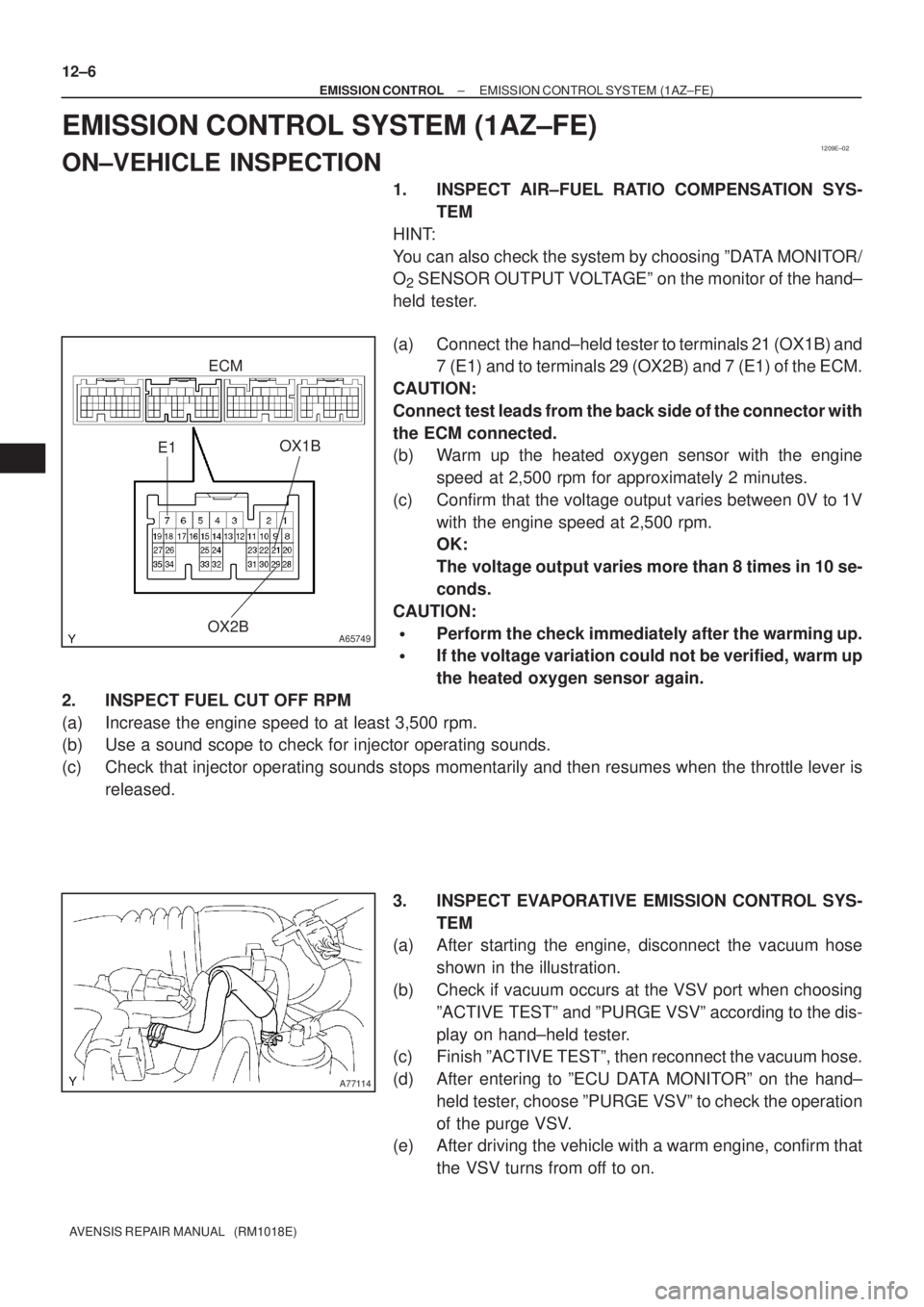
1209E±02
A65749
E1
OX2BOX1B
ECM
A77114
12±6
± EMISSION CONTROLEMISSION CONTROL SYSTEM (1AZ±FE)
AVENSIS REPAIR MANUAL (RM1018E)
EMISSION CONTROL SYSTEM (1AZ±FE)
ON±VEHICLE INSPECTION
1. INSPECT AIR±FUEL RATIO COMPENSATION SYS-
TEM
HINT:
You can also check the system by choosing ºDATA MONITOR/
O
2 SENSOR OUTPUT VOLTAGEº on the monitor of the hand±
held tester.
(a) Connect the hand±held tester to terminals 21 (OX1B) and
7 (E1) and to terminals 29 (OX2B) and 7 (E1) of the ECM.
CAUTION:
Connect test leads from the back side of the connector with
the ECM connected.
(b) Warm up the heated oxygen sensor with the engine
speed at 2,500 rpm for approximately 2 minutes.
(c) Confirm that the voltage output varies between 0V to 1V
with the engine speed at 2,500 rpm.
OK:
The voltage output varies more than 8 times in 10 se-
conds.
CAUTION:
�Perform the check immediately after the warming up.
�If the voltage variation could not be verified, warm up
the heated oxygen sensor again.
2. INSPECT FUEL CUT OFF RPM
(a) Increase the engine speed to at least 3,500 rpm.
(b) Use a sound scope to check for injector operating sounds.
(c) Check that injector operating sounds stops momentarily and then resumes when the throttle lever is
released.
3. INSPECT EVAPORATIVE EMISSION CONTROL SYS-
TEM
(a) After starting the engine, disconnect the vacuum hose
shown in the illustration.
(b) Check if vacuum occurs at the VSV port when choosing
ºACTIVE TESTº and ºPURGE VSVº according to the dis-
play on hand±held tester.
(c) Finish ºACTIVE TESTº, then reconnect the vacuum hose.
(d) After entering to ºECU DATA MONITORº on the hand±
held tester, choose ºPURGE VSVº to check the operation
of the purge VSV.
(e) After driving the vehicle with a warm engine, confirm that
the VSV turns from off to on.
Page 220 of 1690
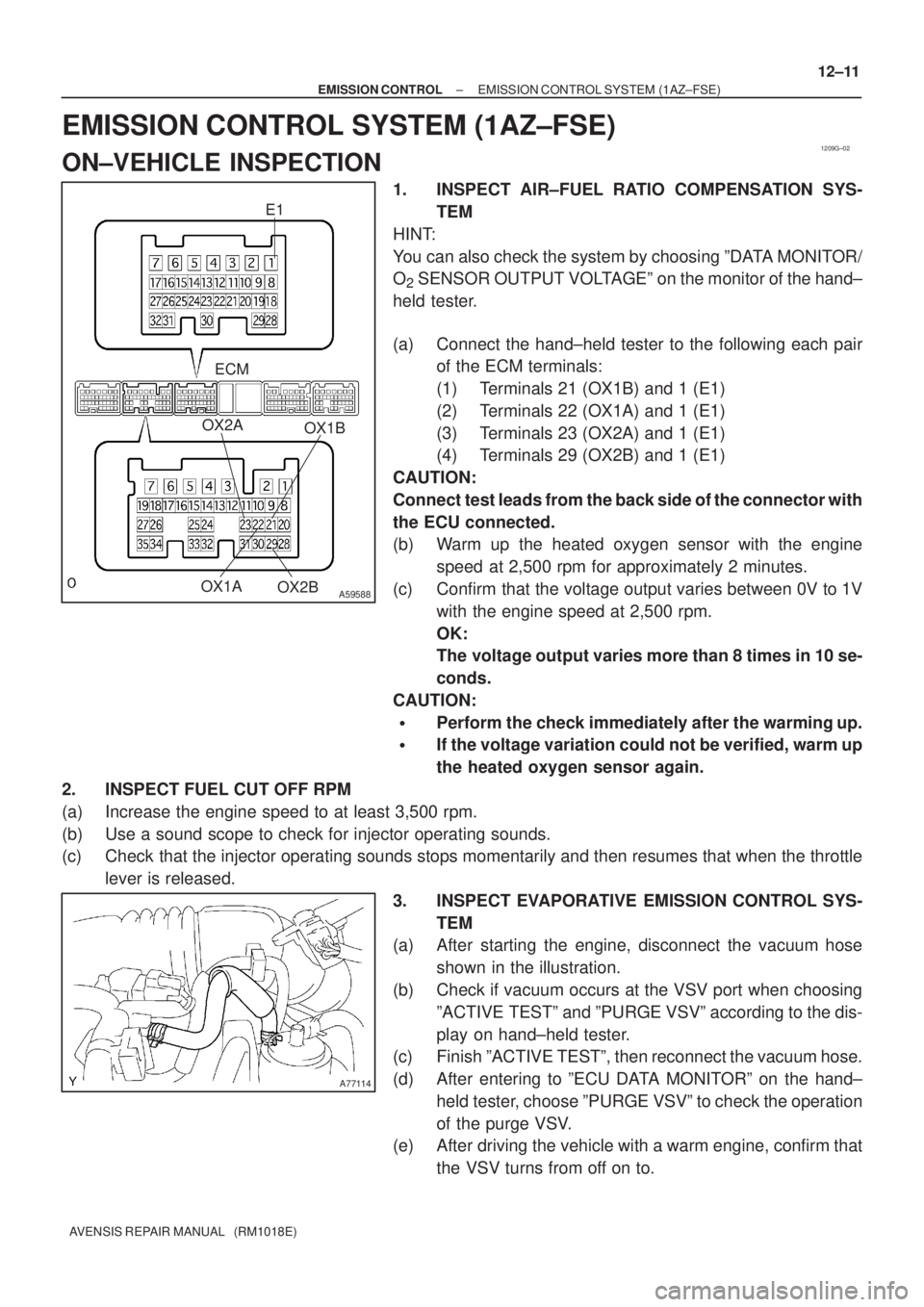
1209G±02
A59588
E1
OX1AOX1B
OX2B OX2A
ECM
A77114
± EMISSION CONTROLEMISSION CONTROL SYSTEM (1AZ±FSE)
12±11
AVENSIS REPAIR MANUAL (RM1018E)
EMISSION CONTROL SYSTEM (1AZ±FSE)
ON±VEHICLE INSPECTION
1. INSPECT AIR±FUEL RATIO COMPENSATION SYS-
TEM
HINT:
You can also check the system by choosing ºDATA MONITOR/
O
2 SENSOR OUTPUT VOLTAGEº on the monitor of the hand±
held tester.
(a) Connect the hand±held tester to the following each pair
of the ECM terminals:
(1) Terminals 21 (OX1B) and 1 (E1)
(2) Terminals 22 (OX1A) and 1 (E1)
(3) Terminals 23 (OX2A) and 1 (E1)
(4) Terminals 29 (OX2B) and 1 (E1)
CAUTION:
Connect test leads from the back side of the connector with
the ECU connected.
(b) Warm up the heated oxygen sensor with the engine
speed at 2,500 rpm for approximately 2 minutes.
(c) Confirm that the voltage output varies between 0V to 1V
with the engine speed at 2,500 rpm.
OK:
The voltage output varies more than 8 times in 10 se-
conds.
CAUTION:
�Perform the check immediately after the warming up.
�If the voltage variation could not be verified, warm up
the heated oxygen sensor again.
2. INSPECT FUEL CUT OFF RPM
(a) Increase the engine speed to at least 3,500 rpm.
(b) Use a sound scope to check for injector operating sounds.
(c) Check that the injector operating sounds stops momentarily and then resumes that when the throttle
lever is released.
3. INSPECT EVAPORATIVE EMISSION CONTROL SYS-
TEM
(a) After starting the engine, disconnect the vacuum hose
shown in the illustration.
(b) Check if vacuum occurs at the VSV port when choosing
ºACTIVE TESTº and ºPURGE VSVº according to the dis-
play on hand±held tester.
(c) Finish ºACTIVE TESTº, then reconnect the vacuum hose.
(d) After entering to ºECU DATA MONITORº on the hand±
held tester, choose ºPURGE VSVº to check the operation
of the purge VSV.
(e) After driving the vehicle with a warm engine, confirm that
the VSV turns from off on to.
Page 222 of 1690
1203V±03
B08075
12±16
± EMISSION CONTROLEMISSION CONTROL SYSTEM (1CD±FTV)
AVENSIS REPAIR MANUAL (RM1018E)
EMISSION CONTROL SYSTEM (1CD±FTV)
ON±VEHICLE INSPECTION
1. VISUALLY INSPECT HOSES, CONNECTIONS AND
GASKETS
(a) Check for cracks, leak or damage.
HINT:
Separation of the engine oil dipstick, oil filler cap, PCV hose,
etc. may cause the engine to run improperly. Disconnection,
looseness or cracks in the parts of the air induction system be-
tween the throttle body and cylinder head will allow air suction
and cause the engine to run improperly.
Page 226 of 1690
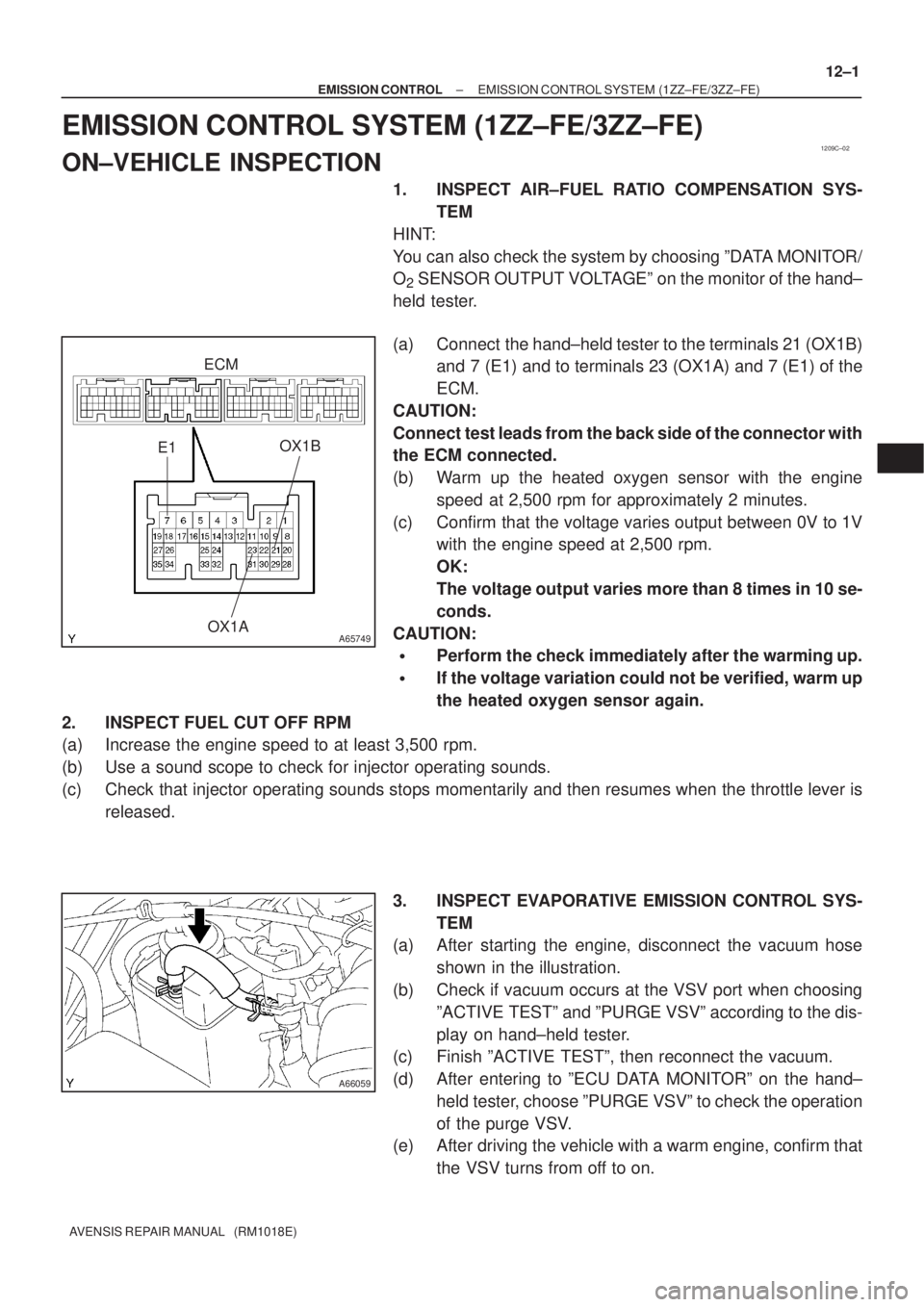
1209C±02
A65749
E1
OX1AOX1B
ECM
A66059
± EMISSION CONTROLEMISSION CONTROL SYSTEM (1ZZ±FE/3ZZ±FE)
12±1
AVENSIS REPAIR MANUAL (RM1018E)
EMISSION CONTROL SYSTEM (1ZZ±FE/3ZZ±FE)
ON±VEHICLE INSPECTION
1. INSPECT AIR±FUEL RATIO COMPENSATION SYS-
TEM
HINT:
You can also check the system by choosing ºDATA MONITOR/
O
2 SENSOR OUTPUT VOLTAGEº on the monitor of the hand±
held tester.
(a) Connect the hand±held tester to the terminals 21 (OX1B)
and 7 (E1) and to terminals 23 (OX1A) and 7 (E1) of the
ECM.
CAUTION:
Connect test leads from the back side of the connector with
the ECM connected.
(b) Warm up the heated oxygen sensor with the engine
speed at 2,500 rpm for approximately 2 minutes.
(c) Confirm that the voltage varies output between 0V to 1V
with the engine speed at 2,500 rpm.
OK:
The voltage output varies more than 8 times in 10 se-
conds.
CAUTION:
�Perform the check immediately after the warming up.
�If the voltage variation could not be verified, warm up
the heated oxygen sensor again.
2. INSPECT FUEL CUT OFF RPM
(a) Increase the engine speed to at least 3,500 rpm.
(b) Use a sound scope to check for injector operating sounds.
(c) Check that injector operating sounds stops momentarily and then resumes when the throttle lever is
released.
3. INSPECT EVAPORATIVE EMISSION CONTROL SYS-
TEM
(a) After starting the engine, disconnect the vacuum hose
shown in the illustration.
(b) Check if vacuum occurs at the VSV port when choosing
ºACTIVE TESTº and ºPURGE VSVº according to the dis-
play on hand±held tester.
(c) Finish ºACTIVE TESTº, then reconnect the vacuum.
(d) After entering to ºECU DATA MONITORº on the hand±
held tester, choose ºPURGE VSVº to check the operation
of the purge VSV.
(e) After driving the vehicle with a warm engine, confirm that
the VSV turns from off to on.
Page 227 of 1690
A62836
1ZZ±FE
3ZZ±FE
12±2
± EMISSION CONTROLEMISSION CONTROL SYSTEM (1ZZ±FE/3ZZ±FE)
AVENSIS REPAIR MANUAL (RM1018E)
4. VISUALLY INSPECT HOSES, CONNECTIONS AND
GASKETS
(a) Check for cracks, leaks or damage.
HINT:
Separation of the engine oil dipstick, oil filler cap, PCV hose,
etc. may cause the engine to run improperly. Disconnection,
looseness or cracks in the parts of the air induction system be-
tween the throttle body and cylinder head will allow air suction
and cause the engine to run improperly.
Page 231 of 1690
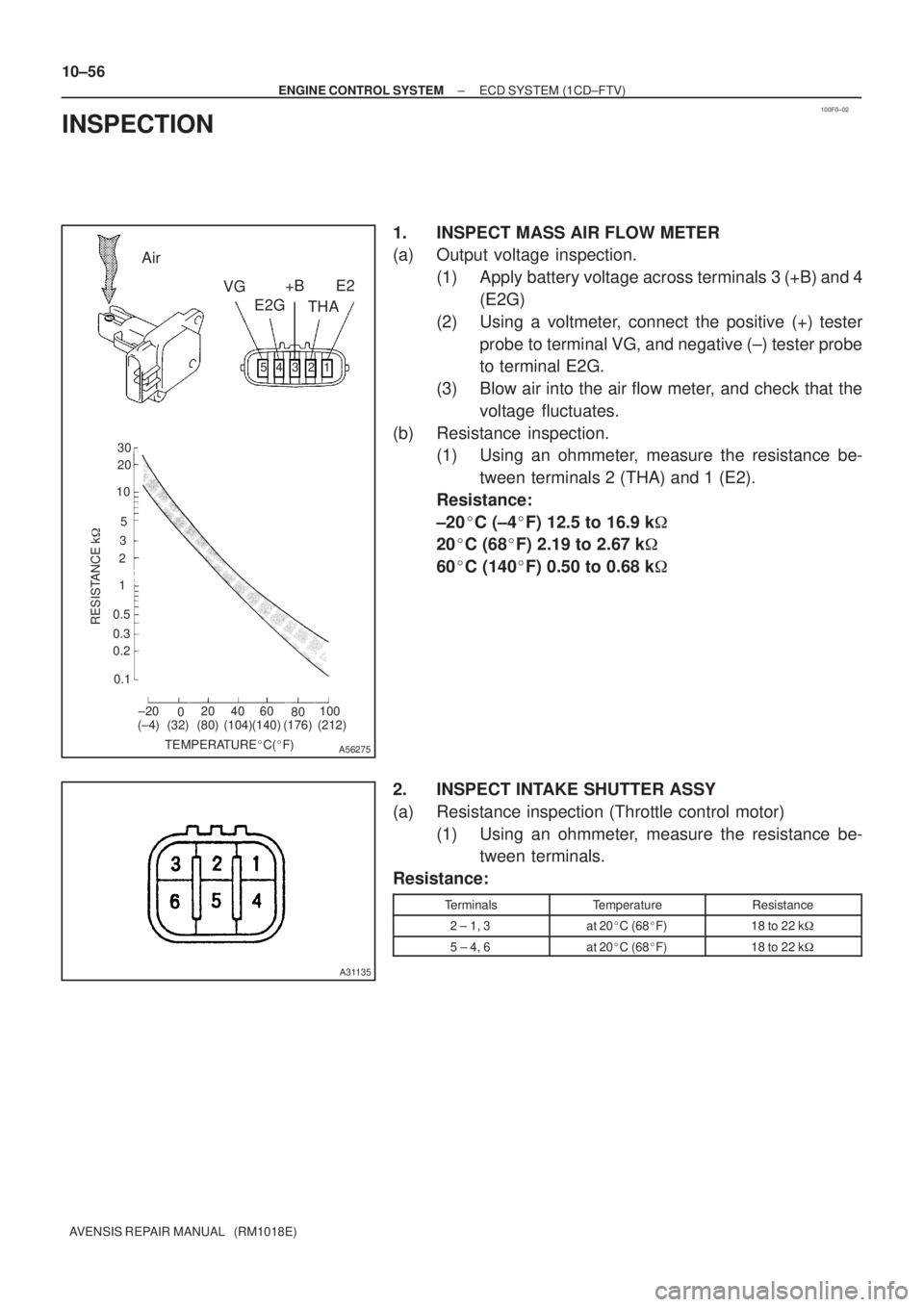
100F0±02
321 4 5
±20
020 40 60
80100 0.1 0.2 0.3 0.51 235 1020 30
TEMPERATURE�C(�F)
RESISTANCE k�
(±4) (32) (80) (140)(104) (212)(176)
A56275
VG
E2G
THA +B E2 Air
A31135
10±56
± ENGINE CONTROL SYSTEMECD SYSTEM (1CD±FTV)
AVENSIS REPAIR MANUAL (RM1018E)
INSPECTION
1. INSPECT MASS AIR FLOW METER
(a) Output voltage inspection.
(1) Apply battery voltage across terminals 3 (+B) and 4
(E2G)
(2) Using a voltmeter, connect the positive (+) tester
probe to terminal VG, and negative (±) tester probe
to terminal E2G.
(3) Blow air into the air flow meter, and check that the
voltage fluctuates.
(b) Resistance inspection.
(1) Using an ohmmeter, measure the resistance be-
tween terminals 2 (THA) and 1 (E2).
Resistance:
±20�C (±4�F) 12.5 to 16.9 k�
20�C (68�F) 2.19 to 2.67 k�
60�C (140�F) 0.50 to 0.68 k�
2. INSPECT INTAKE SHUTTER ASSY
(a) Resistance inspection (Throttle control motor)
(1) Using an ohmmeter, measure the resistance be-
tween terminals.
Resistance:
TerminalsTemperatureResistance
2 ± 1, 3at 20�C (68�F)18 to 22 k�
5 ± 4, 6at 20�C (68�F)18 to 22 k�
Page 232 of 1690

������������
30
20
10
5
3
02040 0.11
0.3
0.2 0.52
60 80 100 ±20
(±4) (104) (140) (176)(32) (68) (212)
Z17274
Ohmmeter
Acceptable
Temperature �C (�F)
Resistance k�
THF E2
A30331
30
20
10
�
�
�
�
0.5
0.3
0.2
0.1
±20�
20 4060
80 100
F14741(±4) (104) (140) (176)(32) (68) (212)
A56276
Temperature �C (�F)
Resistance k�
± ENGINE CONTROL SYSTEMECD SYSTEM (1CD±FTV)
10±57
AVENSIS REPAIR MANUAL (RM1018E)
3. INSPECT DIESEL ENGINE ENGINE COOLANT
TEMPERATURE SENSOR
(a) Resistance inspection.
(1) Using an ohmmeter, measure the resistance be-
tween each terminal.
Resistance:
Approx. 20�C (68�F) 2.32 to 2.59 k�
Approx. 80�C (176�F) 0.310 to 0.326 k�
NOTICE:
In case of checking the water temperature sensor in the wa-
ter, be careful not to allow water to go into the terminals,
and after checking, wipe out the sensor.
4. INSPECT INJECTION OR SUPPLY PUMP ASSY
(a) Resistance inspection. (Fuel temperature sensor)
(1) Using an ohmmeter, measure the resistance be-
tween each terminal.
Resistance:
Approx. 20�C (68�F) 2.21 to 2.69 k�
Approx. 80�C (176�F) 0.287 to 0.349 k�
5. INSPECT DIESEL TURBO INLET AIR TENPERATURE
SENSOR
(a) Resistance inspection.
(1) Using an ohmmeter, measure the resistance be-
tween each terminal.
Resistance:
Approx. 20�C (68�F) 2.21 to 2.65 k�